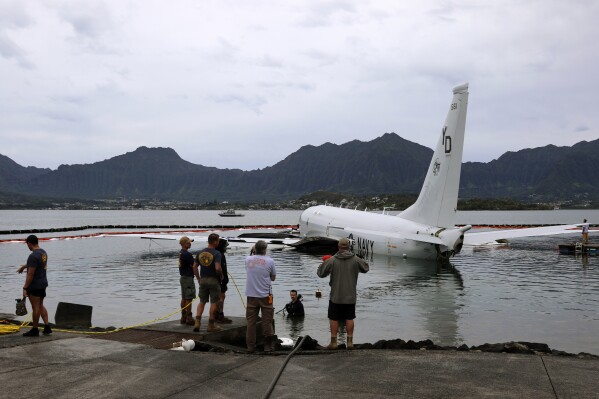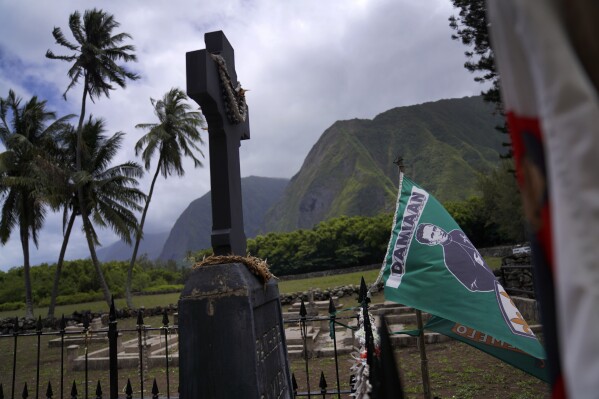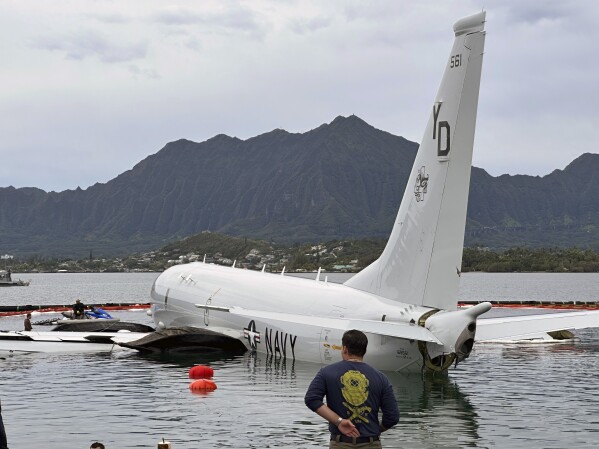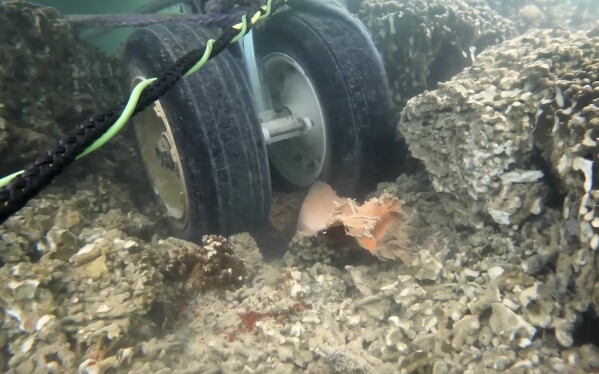US Navy says it will cost $1.5M to salvage jet plane that crashed on Hawaii coral reef
HONOLULU (AP) — The U.S. Navy estimates it will cost $1.5 million to salvage a jet plane that crashed on a coral reef in Hawaii nearly two weeks ago, officials said Saturday.
Navy spokesman Mohammad Issa said the salvage efforts are focused on protecting the environment and safely recovering the aircraft in a way that retains its combat capability. He said $200,000 has already been spent on the operation.
The Navy plans to use inflatable cylinders to lift and roll the jet plane off the reef where it crashed on Nov. 20.
The P-8A, the military’s version of a Boeing 737 jet, slammed into an environmentally sensitive bay about 10 miles (16 kilometers) from Honolulu when it overshot the runway at Marine Corps Base Hawaii. None of the nine people on board were injured. The cause of the crash is under investigation.
 US military affirms it will end live-fire training in Hawaii’s Makua Valley
US military affirms it will end live-fire training in Hawaii’s Makua Valley
 US Navy plans to raise jet plane off Hawaii coral reef using inflatable cylinders
US Navy plans to raise jet plane off Hawaii coral reef using inflatable cylinders
 Pilgrims yearn to visit an isolated peninsula where Catholic saints cared for Hawaii’s leprosy patients
Pilgrims yearn to visit an isolated peninsula where Catholic saints cared for Hawaii’s leprosy patients
Rear Adm. Kevin Lenox, the commander of Carrier Strike Group 3 who is leading the salvage effort, said Friday he is confident the operation can be carried out without further damaging the reef.
The Navy released underwater video on Wednesday showing the aircraft’s landing gear wheels resting on parts of crushed coral and much of the rest of the plane floating above the reef in Kaneohe Bay.

Contractors place inflatable bags under a U.S. Navy P-8A in Kaneohe Bay, Hawaii, Friday, Dec. 1, 2023, so they can float the aircraft over the water and onto land. The Navy plans to use inflatable cylinders to lift the jet off a coral reef and then roll it over to a runway to remove the plane from the ocean where it crashed the week before. (AP Photo/Audrey McAvoy)
A Navy team has removed nearly all of the estimated 2,000 gallons (7,500 liters) of fuel from the aircraft.
Hawaii state officials are due to examine the reef for damage once the plane is removed.
Kaneohe Bay is home to coral reefs and a range of marine life, from sharks to octopus and fish. The area hosts an ancient Hawaiian fishpond being restored by community groups.
Contractors performed a similar feat when they removed a barge weighing 1,000 tons (907 metric tons) from sensitive seagrass habitat in the Outer Banks of North Carolina after Hurricane Florence in 2015.

In this image taken from video provided by the U.S. Navy, Navy divers assigned to Mobile Diving and Salvage Unit One (MDSU-1) conduct an underwater survey of the U.S. Navy’s P-8A Poseidon in Kaneohe Bay, Hawaii, on Tuesday, Nov. 28, 2023. The U.S. Navy said the underwater footage shows two points where the large plane is touching coral in the Hawaii bay. It’s been more than a week since the Navy plane overshot a runway and landed in shallow water just offshore of Marine Corps Base Hawaii at Kaneohe Bay. (U.S. Navy via AP)
The plane weighs about 60 tons (54 metric tons).
The Navy considered floating the jet within range of a crane on the runway and then lifting the plane onto land. But Lenox said the inflatable cylinder option was the safer method, was expected to have little to no effect on the coral and would not impact the aircraft.
The jet is in good condition and the Navy hopes to get it flying again, Lenox said.
The Navy uses the P-8A to search for submarines and conduct surveillance and reconnaissance.
The Boeing-made plane is assigned to Patrol Squadron 4 stationed at Whidbey Island in Washington state. A separate crew from Whidbey Island has deployed to Hawaii to take over the squadron’s patrol missions near Hawaii.
Disclaimer: The copyright of this article belongs to the original author. Reposting this article is solely for the purpose of information dissemination and does not constitute any investment advice. If there is any infringement, please contact us immediately. We will make corrections or deletions as necessary. Thank you.

